Radiocarbon chronology and isotope data of Ust-Tartasskiye Kurgany Mound 51, the Baraba forest-steppe
Автор: Mylnikova L.N., Parkhomchuk E.V., Molodin V.I., Menshanov P.N., Babina K.A., Nenakhov D.A., Chikisheva T.A.
Журнал: Archaeology, Ethnology & Anthropology of Eurasia @journal-aeae-en
Рубрика: The metal ages and medieval period
Статья в выпуске: 3 т.52, 2024 года.
Бесплатный доступ
Results of radiocarbon dating of items from mound No. 51 of Ust-Tartasskiye Kurgany burial ground are presented. This is a key site of the Sargat culture in Baraba. Characteristics of samples and pretreatment procedure are provided. Twenty-four radiocarbon dates were generated. Radiocarbon ages correlate with biological ages of the deceased persons. Bayesian KDE chronology modeling suggests a short-term intense use of the site for burying those who died between the 3rd and 1st centuries BC. Based on MCMC-modeling, a conclusion is reached about two periods in the use of the space allotted for graves between 200–40 BC. Burials of the “first period” (~25 %) could have been repeatedly made before 150 BC. Most burials (~75 %) were likely arranged between 150–120 BC. The last burial in the mound (no earlier than 110 BC) is No. 13. Minor differences in 15N isotope apparently evidence various diets of males and females at the second period.
Короткий адрес: https://sciup.org/145147217
IDR: 145147217 | DOI: 10.17746/1563-0110.2024.52.3.056-066
Текст научной статьи Radiocarbon chronology and isotope data of Ust-Tartasskiye Kurgany Mound 51, the Baraba forest-steppe
The Sargat culture, encompassing the basin of the Tobol, Ishim, and Irtysh rivers and the Baraba Lowland, is one of the best studied Early Iron Age cultures in the West Siberian forest-steppe. Bearers of this culture dwelt there for almost a thousand years. On the basis of the regional specifics, specialists separate several local variants of the Sargat culture (Koryakova, 1988; Matveeva, 1993, 1994; Mogilnikov, 1997). The eastern periphery of this culture spread is referred to as the Baraba variant, which moved through four stages of development (Polosmak, 1987: 96).
By now, 15 sites of the Sargat culture have been examined in the Baraba forest-steppe. Ust-Tartasskiye Kurgany burial ground occupies a special place among them. The site has been known since the 18th century (Polnoye sobraniye…, 1824; Ekspeditsiya…, 1768–1774; Florinsky, 1889). S.M. Chugunov conducted the first excavations there in 1895 and
1896 (Archives of the Institute of Material Culture RAS. F. 1, Inv. 1. 1895, D. 80; F. 1, Inv. 1. 1896, D. 71) (Chugunov, 1900; Troitskaya, Avtushkova, 2010). The site was studied by A.M. Molotilov (1912), I.A. Talitskaya (1953), T.N. Troitskaya (1966), and V.A. Borzunov (1971). Excavations were conducted at the site under the leadership of V.I. Molodin (Molodin, 1979; Molodin, Novikov, 1998), D.G. Savinov, and N.V. Polosmak (Savinov, Polosmak, 1985; Polosmak, 1987).
Ust-Tartasskiye Kurgany is the largest burial ground of the Sargat culture in Baraba. According to V.M. Florinsky (1889: 46), it included 256 mounds. S.M. Chugunov mentioned as many as 122 mounds. According to the data received by the State Science Center for Preservation of Cultural Heritage of the Novosibirsk Region, 54 mounds were preserved in 2017 (Knyazev, 2018); the rest of them were annihilated during decades of plowing and repair of the Moscow Highway.
In 2022, archaeological teams from the Institute of Archaeology and Ethnography SB RAS excavated burial mound (kurgan) No. 51 (Mylnikova et al., 2022). Ust-Tartasskiye Kurgany is located on the left bedrock terrace of the Tartas River, and from the confluence of the Tartas and Om rivers, on the right fluvial terrace of the Om (Tai tract), on both sides of the Vengerovo-Kuibyshev road (the so-called Old Moscow Highway), in the Vengerovsky District of the Novosibirsk Region (Fig. 1). Mound No. 51 is situated 5.14 km southeast of a bell tower in Vengerovo village (Molodin, Novikov, 1998; Troitskaya, Molodin, Sobolev, 1980). Excavations in the burial space surrounded by a small ditch revealed 22 burials attributable to a single epoch, but made at different times (Mylnikova et al., 2022). In terms of topography and stratigraphy, several periods were separated. The main burial of the mound was central grave No. 9 (Fig. 2). The grave of an adult man was almost completely looted. Simultaneously with the main burial (before the mound was formed), graves No. 7, 11, 12, 16–18, and 20 had been made along the perimeter. Their common trait was a shallow depth (up to 0.4 m). Despite their looting, almost every grave contained remains of birch bark used as a cover. Graves No. 14, 15, 19, and 21 were built in the rows of the above-mentioned ones. Their distinguishing trait was a considerable depth (up to 2 m). Grave No. 13, possibly, the latest one among the flat burials, had no birch bark cover. Most graves contained burial goods typical of the Sargat culture. Graves No. 13– 15, 19, and 21 were not looted. Nine intrusive burials,
Fig. 1 . Location of mound No. 51 of the Ust-Tartasskiye Kurgany burial ground.
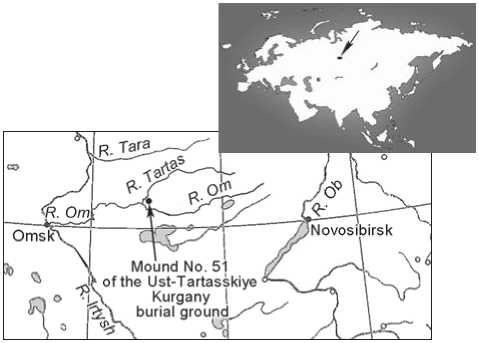
apparently secondary (Ibid.), were found in the mound (No. 1+3; 2, 4, 5, 6, 8, 10, 22, 23). Female (No. 5, 11, 13, 15–17, 19), male (No. 3, 4, 6, 7, 9, 10, 14, 21, 22), infant (No. 18), and unidentifiable (No. 1, 2, 8, 12, 20) burials were recognized.
Material and methods
Twenty-four samples were subjected to pretreatment for accelerator mass spectrometry (AMS) in the Center for Collective Use “Geochronology of the Cenozoic” (Institute of Archaeology and Ethnology SB RAS): 16 human teeth separated from bone fragments; 1 fragment of a human bone, 5 fragments of birch bark, 1 fragment of wood from the roof, and 1 charcoal (see Table ).
Teeth and bone fragments were cleaned, washed with distilled water, dried, and ground down into powder in Freezer Mill cryogenic grinder. Then the powder was purified using the dichlormethane solvent, with continual stirring at room temperature during 2 days; the powder was dried at 60 °C. The bone was demineralized in 1 М HCl solution at 4 °C during a day and a half. After that, the solution was centrifuged; the received precipitate was washed with distilled water to reach рН = 7. To remove humic contaminants from collagen, the precipitate was treated with 0.1 М NaOH solution at room temperature to receive a colorless solution; then the precipitate was washed with distilled water to рН = 7. The washed precipitate was again put in 1 М HCl solution for 30–60 minutes and then treated with distilled water to receive the suspension with рН = 3. The suspension was kept in a thermostat at 70 °C during 3 days. The precipitate was extracted from the solution in centrifuge. The purified solution was kept at -20 °C before freeze-drying to receive collagen powder. Immediately before carbonization,
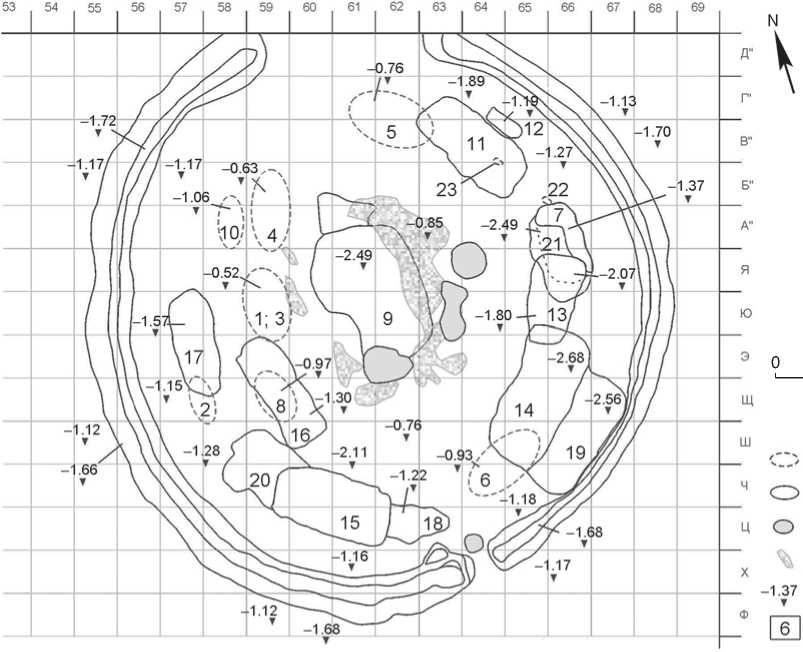
1 m
Fig. 2. Plan of mound No. 51 of the Ust-Tartasskiye Kurgany burial ground.
1 – burial in the mound; 2 – burial dug into the ground; 3 – charred earth; 4 – birch bark; 5 – level mark; 6 – burial number.
prepared solutions were freeze-dried in a FreeZone Labonco drier.
In order to extract cellulose from birch bark and wood, the samples were cleaned (roots and other visible contamination were removed), ground, and subjected to solvent extraction with the use of automatic ASETM350 (Accelerated Solvent Extractor – Dionex Corporation) by mixture of ethylene chloride and ethanol in the ratio of 2:1 at 90 °C during 10 minutes, with subsequent washing with distilled water at 90 °C during 10 minutes. Then the samples were repeatedly processed in the following way. Each sample was placed in the 20 ml solution of catalyst and oxidant and kept there for two or three days under boiling conditions. The catalyst and oxidant solution was received by dissolution of 0.2 g of sodium tungstate dehydrate in 40 ml of 5 % sulfuric acid. The formed yellow precipitate was dissolved in 40 ml of 10 % hydrogen peroxide solution. During this period, the catalyst solution has been changed several times. After that, the samples were repeatedly washed with distilled water and treated by 0.5 М NaOH at 70 °C during 20 minutes to reach рН = 7. This procedure was repeated twice. Then the cellulose samples were bleached. Each sample was placed in the solution consisting of 4 ml of NaClO2, 16 ml of H2O, and 300 mcl of 1 М HCl and kept there at 80 °C to the maximal discoloration of the solution and the samples. After that, the samples were washed with distilled water to рН = 7 и freeze-dried in a FreeZone Labonco drier.
Acid-Base-Acid pretreatment was used for charcoal sample. First, the sample powder was placed in 1 М HCl, kept there during 20 minutes at 80 °C, and washed to рН = 7. Then the precipitate was poured into 1 М NaOH and kept there during 20 minutes at 80 °C. After that, the specimen was washed several times with 1 М NaOH solution and distilled water to рН = 7. Then the precipitate was kept in concentrated HF for 48 hours, poured into concentrated HCl, and kept there during 30 minutes at 80 °C. Finally, the charcoal sample was washed with distilled water to рН = 7 and dried at 60 °C.
All prepared and dried samples were delivered for AMS-analysis to the AMS Golden Valley (GV) Center, where they were carbonized using AGE-3 (Ionplus) graphitization equipment and examined by AMS
Radiocarbon and calendar ages of samples from mound No. 51 of the Ust-Tartasskiye Kurgany burial ground
|
No. |
Burial number |
Laboratory code |
Dated material |
Radiocarbon age, years |
Calendar age, years BC 1σ |
d13C, ‰ graphite |
d13C, ‰ collagen |
d15N, ‰ |
C/N |
|
1 |
14 |
GV-4235 |
Human tooth |
2203 ± 32 |
372–174 |
-23.6 |
-22.2 |
12.6 |
3.1 |
|
2 |
GV-4236 |
Birch bark |
1967 ± 32 |
42–126 |
-36.5 |
-28.6 |
– |
– |
|
|
3 |
21 |
GV-4245 |
Human tooth |
2173 ± 32 |
362–241 (49.4 %) 236–106 (46.0 %) |
-23.1 |
-22.7 |
13.5 |
3.2 |
|
4 |
GV-4243 |
Birch bark |
2010 ± 42 |
106–122 |
-25.6 |
-26.8 |
– |
– |
|
|
5 |
GV-4244 |
Charcoal |
1995 ± 41 |
96–72 (2.6 %) 57–125 (92.8 %) |
-26.6 |
-25.1 |
– |
– |
|
|
6 |
6 |
GV-4247 |
Human tooth |
2163 ± 32 |
359–276 (38 %) 235–97 (53.4 %) |
-17.0 |
-22.8 |
13.8 |
3.2 |
|
7 |
19 |
GV-4242 |
ʺ |
2149 ± 32 |
354–284 (26.9 %) 229–90 (63 %) 80–53 (5.6 %) |
-23.1 |
-21.2 |
12.3 |
3.1 |
|
8 |
GV-4241 |
Birch bark |
2026 ± 32 |
106–78 |
-30.7 |
-29.6 |
– |
– |
|
|
9 |
5 |
GV-4226 |
Human tooth |
2142 ± 32 |
351–290 (21 %) 210–52 (73.8 %) |
-23.6 |
-22.6 |
13.0 |
3.2 |
|
10 |
16 |
GV-4238 |
ʺ |
2129 ± 32 |
349–311 (11.6 %) 206–48 (83.9 %) |
-22.0 |
-22.5 |
12.9 |
3.1 |
|
11 |
4 |
GV-4225 |
ʺ |
2125 ± 34 |
349–311 (10.4 %) 206–46 (85 %) |
-25.3 |
-22.7 |
12.3 |
3.3 |
|
12 |
3 |
GV-4224 |
ʺ |
2120 ± 41 |
351–290 (12.1 %) 210–40 (82.5 %) |
-22.2 |
-22.4 |
11.5 |
3.2 |
|
13 |
9 |
GV-4230 |
Human bone |
2117 ± 32 |
343–321 (5.7 %) 202–47 (89.7 %) |
-23.2 |
-21.8 |
12.4 |
3.3 |
|
14 |
GV-4229 |
Human tooth |
2095 ± 32 |
198–39 (93.1 %) 11–2 (1.9 %) |
-20.8 |
-20.8 |
12.1 |
3.3 |
|
|
15 |
GV-4228 |
Birch bark |
2224 ± 34 |
387–197 (95.4 %) |
-31.0 |
-29.9 |
– |
– |
|
|
16 |
22 |
GV-4246 |
Human tooth, skeleton 1 |
2113 ± 33 |
343–322 (4.9 %) 201–45 (90.6 %) |
-21.1 |
-21.1 |
12.3 |
3.2 |
|
17 |
7 |
GV-4227 |
Human tooth |
2104 ± 31 |
339–326 (2.2 %) 199–43 (93.3 %) |
-23.0 |
-21.5 |
12.7 |
– |
|
18 |
15 |
GV-4237 |
ʺ |
2098 ± 32 |
198–41 (93.2 %) 9–1 (1.2 %) |
-20.3 |
-22.2 |
13.2 |
3.2 |
|
19 |
11 |
GV-4232 |
ʺ |
2094 ± 32 |
197–39 (93.3 %) 11–2 (2.1 %) |
-24.8 |
-22.0 |
12.8 |
3.3 |
|
20 |
GV-4233 |
Birch bark |
1985 ± 33 |
46–120 |
-31.6 |
-27.1 |
– |
– |
|
|
21 |
10 |
GV-4231 |
Human tooth |
2091 ± 32 |
197–37 (92.4 %) 14–4 (3 %) |
-20.8 |
-21.1 |
11.7 |
– |
|
22 |
13 |
GV-4234 |
ʺ |
2087 ± 32 |
197–35 (91.4 %) 15–6 (4.1 %) |
-19.7 |
-21.5 |
13.5 |
3.2 |
|
23 |
18 |
GV-4240 |
ʺ |
2085 ± 32 |
196–33 (90.7 %) 16–7 (4.7 %) |
-23.4 |
-21.3 |
12.3 |
– |
|
24 |
17 |
GV-4239 |
Wood fragment |
1923 ± 34 |
22–212 |
-24.7 |
-27.1 |
– |
– |
MICADAS-28 (Ionplus) facility. Radiocarbon age was estimated using the BATS software. Normalization was performed using the standard ОX-I (SRM 4990B) sample by subtraction of the baseline value, estimated from the standard polyethylene sample (BN 268530 Thermo Scientific) corrected for isotopic shift measured for 13С in graphites on MICADAS-28.
Calibration of radiocarbon age estimates and modeling of chronology were performed using the OxCal 4.4 software. Preliminary KDE-modeling was carried out in accordance with (Ramsey, 2017), and improved traditional MCMC-modeling in accordance with (Ramsey, 2009). Convergence of models was determined by the agreement index (Аmodel), without limits on time and number of modeling steps. Stability of results was estimated through at least 10 repetitions with А мodel > 60.
Measurements of δ13C and δ15N in the tooth and bone samples were conducted using Delta-V-Advantage mass spectrometer, under conditions of continuous flow of high-purity (grade 6.0) helium: δ13C and δ15N were estimated for sample weights of 0.150–0.250 mg by СО2 and N2, obtained through decomposition of substances at 1020 °C, relatively to СО2 extracted from a standard of ANU sucrose and IVA urea, respectively, obtained under the same conditions. Isotopic shift was measured by 13С for wood samples and by 13C and 15N for bone samples. Reproducibility of the generated values was within ± 0.2 %.
To determine the quality of collagen in teeth and bone samples, content of C, N, and H was measured with Flash-2000 (ThermoScientific) analyzer, under conditions of continuous flow of helium (grade B) for sample weights of 4.0–6.0 mg by СО2 and N2, obtained through decomposition of substances at 920 °C, relatively to the same substances that were extracted from a standard of urea (Urea, ThermoScientific) under the same conditions. Each sample was analyzed twice; experimental reproducibility (standard deviation of the mean) equaled 0.02 and 0.08 wt% for C and N, respectively.
Statistical analysis was carried out with the JASP 16.4 software. Associations between variables were assessed by the Spearman’s R criterion, and linearity of association, by the Pearson’s correlation coefficient under the assumption of positive link between biological and radiocarbon ages. Age variations between groups of burials were evaluated using traditional and Bayesian analyses of variance (ANOVA); age differences between wood and bones, using traditional and Bayesian ANOVA with repeated measurements; a posteriori comparison of group means was conducted via the Benjamini-Hochberg criterion. Differences in isotopic shifts were evaluated by δ13C and δ15N for collagen samples using traditional and Bayesian two-way covariance analysis (ANCOVA), with “sex” as covariate, with regard to burial order. Variation coefficients were compared with the asymptotic test (Feltz, Miller, 1996). When necessary, results were corrected for multiple comparisons. To evaluate the tendencies, significance level was set at p < 0.10, and for statistically significant results, at p < 0.05.
Results and discussion
All the biological and calibrated age estimates are correlated (without burial No. 13: R(13) = +0.47, p = 0.038; including burial 13: R(14)= +0.31, p = 0.12), suggesting a short time span. Preliminary Bayesian KDE-modeling also supports a short time interval over which most burials were arranged, specifically, one of the periods between 220 and 50 BC with at least two peaks (Amodel = 87) (Fig. 3). A weak linearity of correlation between the biological and calibrated ages (r(13) = +0.36, p = 0.097) likely suggests several periods of activity at the site. The results of preliminary modeling support excavation findings: all the samples fall in three groups: burials in the mound; those simultaneous with the central grave; and those in the “first period” graves along the perimeter. The latest burial No. 13 stands apart.
The linear correlation between the biological and calibrated ages for graves in the mound indicates broadly the same period for these burials. A tooth from burial No. 6 apparently moved from an earlier burial to the mound (without burial No. 6: r(3) = +0.76, p = 0.070; with burial No. 6: r(4) = +0.43, p = 0.19) (Fig. 4). A similar comparison of age estimates for the central grave and for the “second period” burials in the mound likewise points to contemporaneity (with burial No. 15: r(3) = +0.57, p = 0.12; without burial No. 15: r (2) = +0.55, p = 0.17).
According to ANOVA, burials in the mound are broadly contemporaneous with the central grave, whereas “first period” burials are indeed earlier than others (F (2.12) = 20.6, p = 0.0001, B 10 = 336.7). Similarly, a high correlation between the biological and calibrated ages of those buried in the mound and those contemporaneous with the central grave also suggests that both groups may be broadly contemporaneous (r (8) = +0.65, p = 0.021) (Fig. 5).
OxCal v4.4.4 Bronk Ramsey (2021); r:5; Atmospheric data from Reimer et al ( 2020)
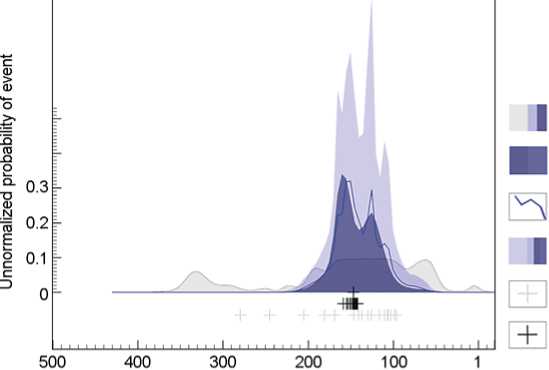
Calibrated age. years BC
Fig. 3. Bayesian KDE-modeling of chronology (after (Ramsey, 2017)).
1 – integral a priori probability of events; 2 – integral a posteriori probability of events; 3 , 4 – averaged LOWESS-regression lines with one s.d. error modeling ranges for posteriori distributions; 5 – a priori ages of individual burials (based on modeling); 6 – a posteriori median ages of individual burials (based on modeling).

Uncalibrated radiocarbon age, years BP
Fig. 4. Correlation between uncalibrated radiocarbon estimates and biological ages of samples from various burials of the complex. Individual estimates are represented as mean values plus significance intervals.
1 – “first period” burials; 2 – “second period” burials; 3 – burials in the mound; 4 – infant burials; 5 – burial No. 13; 6 – a bone and a tooth of a single individual; 7 – range of individual dates contemporaneous with the “second period” burials and those in the mound.
Improved Bayesian modeling of chronology with two peaks and a separate late burial No. 13 (Amodel = 166) (Fig. 6) points to the active use of the site between 200–40 BC; the “first period” burials (~25 %) may have been earlier than 150 BC. The peak of the site usage (~75 %) probably coincided with the 150–120 BC interval, and the latest burial (No. 13) was no earlier than 110 BC (Fig. 7).
Fig. 5. Calibrated median age estimates.
A – “first period” burials; B – “second period” burials; C – burials in the mound; D – p < 0.001 as compared to the buried in the “first period” burials. Groups were compared using ANOVA.
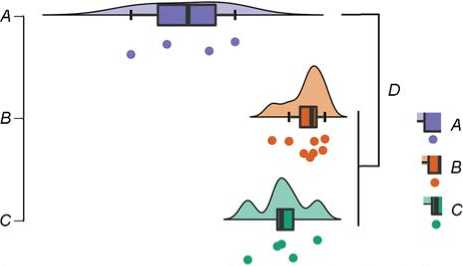
I-------------------------1-------------------------1-------------------------1-------------------------1-------------------------1-------------------------1-------------------------I------------------------- 1
400 350 300 250 200 150 100 50 0
Calibrated age, years BC
Time interval start Sample No. GV4235 GV4245 GV4247 GV4242
GV4226
GV4238
GV4225
GV4224
GV4230
GV4246
GV4227
GV4237
GV4229
GV4232
GV4231
GV4234
GV4240
Time interval end
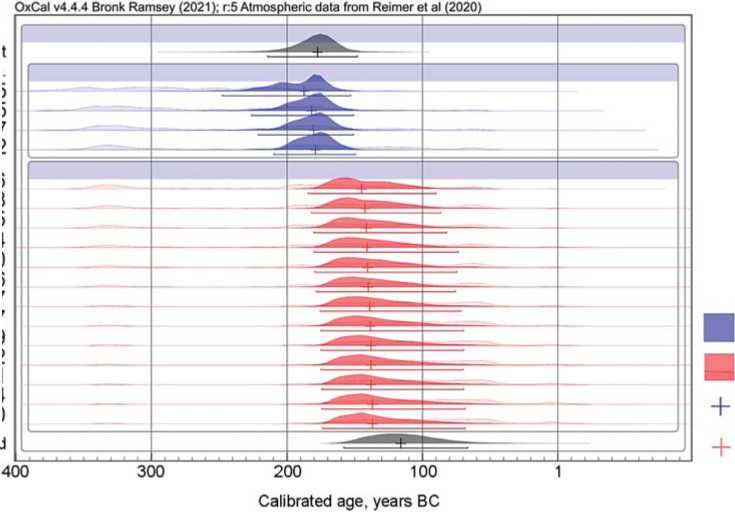
Fig. 6. Bayesian KDE-modeling of chronology (after (Ramsey, 2009)). Distributions and time intervals for burials. 1 – “first period” burials; 2 – “second period” burials, including burial No. 13 (GV-4234) and those in the mound; 3 , 4 – a posteriori modeling of median ages (intervals show 95.4 % probability for each sample).
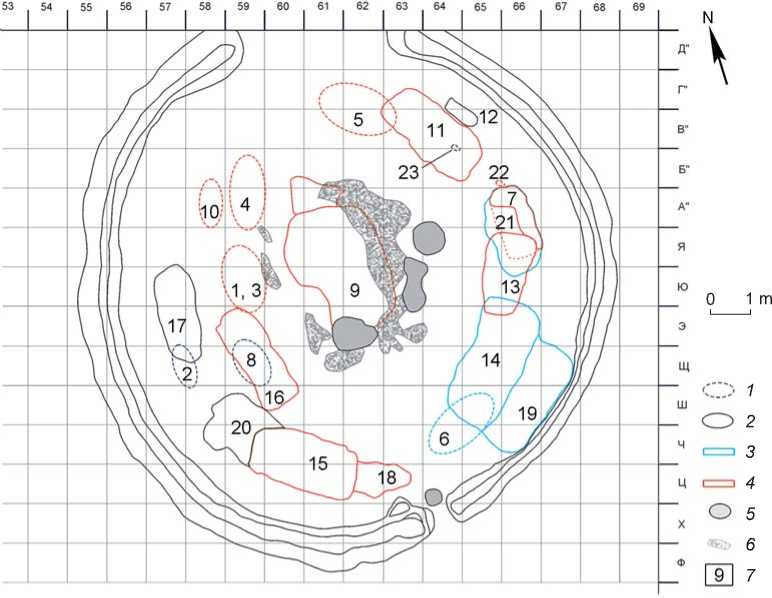
Fig. 7 . Plan of mound No. 51 of the Ust-Tartasskiye Kurgany burial ground.
1 , 2 – undated burials; 3 – “first period” burial; 4 – “second period” burial; 5 – charred earth; 6 – birch bark; 7 – burial number.
Notably, calibrated radiocarbon ages based on wood samples (birch bark, planks of the roof, and charcoal), with the exception of sample GV-4228 from burial No. 9, are significantly younger than those acquired from teeth and bones (F(1.4) = 52.03, p = 0.002, BF 10 = 568.4) (Fig. 8; see Table ). This age difference may be a result of a microbiological stress on wood after burial. Sample GV-4228, judging by its darker, almost black color, had probably been subjected to fire, and was therefore unaffected by later biological changes, hence no carbon had been admixed to the original one contained in the wood. The radiocarbon age of this sample suggests that the earliest burials date to the late 4th century BC. It also cannot be excluded that some wood may be earlier than the burials. To control the effect of standard procedures of sample preparation on the content of radioactive carbon in cellulose and to reveal the reasons underlying the discrepancy between radiocarbon estimates for cellulose and collagen within 150 years, AMS analysis of the same samples of wood was conducted using other methods of chemical processing. The achieved result was the same.
All the burials revealed a small variation in isotopic changes: 13C – 2 ‰ (20.8–22.8 ‰), 15N – 2.3 ‰ (11.5–13.8 ‰) (see Table ) This suggests that all those buried in the mound had subsisted on a similar diet, and that the gap between the periods of intense use of the burial space was rather short.
Isotopic shifts in 13C for dental and bone collagen in samples from burials of both periods are comparable (burial order:
F (1.8) = 0.33, p = 0.69; sex: F (1.8) = 0.29, p = 0.62; BF10 = 0.310 for the “order + sex” model). However, averaged isotopic shifts in 15N for males buried in graves of the “second period” were lower than those for females of the same group and for burials of the “first period” (burial order: F(1.8) = 5.41, p = 0.049; sex: F (1.8) = 5.18, p = 0.052; BF 10 = 0.786 for the “order + sex” model). Consequently, unidentified remains form burials No. 3, 9, and 22 of the “second period”, showing low values of isotopic changes in 15N, are likely those of males.
Coefficients of variation for isotopic changes in 13C based on dental and bone collagen for burials of the periods of CV“first period” = 4.0 %,
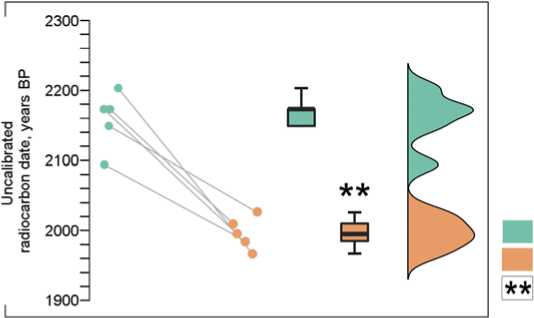
Fig. 8. Uncalibrated radiocarbon dates.
1 – bone samples; 2 – wood samples; 3 – p < 0.002 as compared to human remains. Groups were compared using ANOVA with replications.
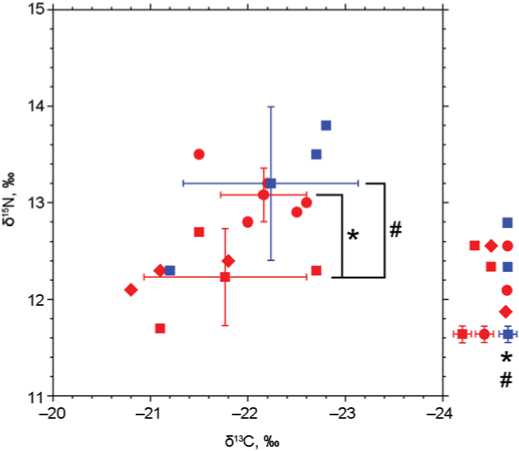
Fig. 9. δ13C and δ15N for the collagen samples from burials of the two periods.
1 – “first period” burials”; 2 – “second period” burials; 3 – male burials; 4 – female burials; 5 – remains unidentified with regard to sex; 6 – mean values for groups of the buried; 7 – p = 0.020 as compared to buried women of the “second period”; 8 – p = 0.049 as compared to burials of the “first period”.
CV males, “second period” = 3.8 %, and CV females, “second period” = = 2.0 % are comparable (p = 0.42). The coefficient of variation for isotopic changes in 15N (2.1 %) for female burials of the “second period” is somewhat lower (p = 0.10) than that for male burials of the “first period” (6.0 %) and “second period” (4.1 %) (Fig. 9).
Small differences in 15N isotopic shifts between the groups of burials suggest that during the second period of site usage, the diet of females contained more protein than that of males. In addition, a lesser variation of 15N changes in females as compared to males indicates a more stable protein diet and a more sedentary life of females on a river abundant in fish. The observed differences may have been caused by sharp climatic changes in the late 2nd century BC in the Iranian highland (Sharifi et al., 2015) and elsewhere in Central Asia (Fedotov et al., 2012).
Conclusions
Multidisciplinary studies have yielded age estimates for 17 of 22 burials excavated in elite mound No. 51 at Ust-Tartasskiye Kurgany, the largest cemetery of the Early Iron Age Sargat culture in the Baraba foreststeppe. This is the first such analysis of a Sargat site. A large series of absolute dates (24) has been assessed, suggesting that the mound dates to the period from the 3rd to the 1st centuries BC. The correlation between radiocarbon ages and the spatial arrangement of burials suggest that the burials were made during largely the same period, on the same platform surrounded by a ditch. Burial rite and accompanying artifacts suggest likewise.
According to the absolute age estimates, there were two overlapping stages in the intense use of the burial platform (see Fig. 6), suggesting that all the burials belong to the same historical period. Four burials of the “first period” were evidently arranged on a small platform encircled by a ditch and open for further burials. Then burial No. 9 was arranged, and the “second period” burials were dug into the virgin soil. During the same period, the mound was constructed, within which more bodies were buried.
The entire time span over which burials were made can be estimated at somewhat more than a century. Given the large size of the cemetery, these periods could differ between the mounds, depending on several factors or their combination, such as the local or social (?) group to which the deceased person belonged, as evidenced by funerary items and physical type (Mylnikova et al., 2022, 2023). An additional analysis of paleogenetic data may be especially informative, being relevant to the origin and kinship of the buried.
The analysis of diet is no less important. At the second period of the mound use, females consumed a more protein rich food than did males. Reasons may include greater mobility of males caused by their pastoral lifestyle, and a sedentary life of women in villages where meat and fish were more available. Interestingly, similar conclusion was reached with regard to a Pazyryk male, whose diet, according to O’Connel (2000), consisted of fish at best rather than meat.
Such interesting and largely unexpected findings concerning the possible diet of the Sargat people need further testing. Results by N.P. Matveeva, based on 14 bone samples from Sargat burials at the Staro-Lybrevo-4 cemetery and Shchelkovo-2 settlement, indicate inequality in resource distribution, specifically deficit of protein in the diet of women and children, and its dominance in the diet of males (Matveeva, Larina, Koliukh, 2003).
The social impact on diet may have been likewise important. It would be interesting to compare diet reconstructions for low-status and elite cemeteries, for instance, for males from the Sidorovka mound (Matyushchenko, Tataurova, 1997).
The study of the Sargat diet has only been started. Findings by N.P. Matveeva (1998, 2000) and her colleagues (Larina, Matveeva, Koliukh, 2001; Matveeva et al., 2003; Chikunova, 2006) concerning social differentiation of burials of that culture, and average indicators of the Sargat diet, can substantially extend our knowledge of the large and diverse ethnocultural phenomenon such as the Sargat culture in Western Siberia.
Acknowledgement
This study was supported by the Russian Science Foundation, Project No. 22-18-00012: “Elite Mounds of the Early Iron Age Sargat Culture in the Ob-Irtysh Forest-Steppe (Novosibirsk Region)”.


